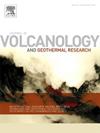含流动晶体的火山圆顶熔岩中的粘脆转变
IF 2.4
3区 地球科学
Q2 GEOSCIENCES, MULTIDISCIPLINARY
Journal of Volcanology and Geothermal Research
Pub Date : 2024-09-30
DOI:10.1016/j.jvolgeores.2024.108198
引用次数: 0
摘要
火山圆顶熔岩的上升和前进是非线性和粘弹性的。目前的圆顶熔岩流变学理论方法是基于粘性悬浮液的流变学定律,而经验实验方法则是基于卷积粘性-脆性变形,两者之间存在不匹配,后者显示了熔岩同时流动和断裂的混合证据。目前缺少的是一个统一的框架,用于理解岩浆等多相悬浮物中以粘性为主的微机械流动机制与包括微裂缝在内的微机械流动机制之间的过渡。在这里,我们利用高温压缩流变学和样品尺度声发射分析来确定富含晶体的火山圆顶熔岩在什么条件下可以通过小尺度的粘性和脆性混合断裂过程流动,从而产生 "噼啪 "声信号,即使在自然界存在中等剪应力的情况下也是如此。通过对直径 60 毫米的大型天然岩浆淬火样品进行多方位渗透率测量,我们发现这种微裂缝流动机制会导致渗透率各向异性,使排气进入相对于流动方向偏离轴线的通道。最后,我们使用一种缩放方法和一个已公布的真实喷发观测数据库来放大我们的发现,并表明在上升的最浅部分和在地球表面的喷发过程中,低孔隙率圆顶岩浆的大体积、表面韧性流动很可能涉及微裂缝和粘性流动的局部混合模式。熔岩前进过程中涉及的微裂缝使实际的含晶熔岩置换与目前大多数基于纯粘性微观机制的流变模型相分离,并表明需要对脆性-粘性混合流的流变学进行修正。通过重新研究已发表的穹隆置换数值模型,我们证明粘脆转变可以在穹隆核心的空间异质区截获。本文章由计算机程序翻译,如有差异,请以英文原文为准。
The viscous-brittle transition in flowing crystal-bearing volcanic dome lavas
The ascent and advance of volcanic dome lava is non-linear and viscoelastic. There exists a mismatch between current theoretical approaches to dome lava rheology, which are based on rheological laws for viscous suspensions, and empirical experimental approaches to convolved viscous-brittle deformation, which show mixed evidence for simultaneous lava flow and fracturing. The missing requirement is a unified framework for understanding the transition between micro-mechanical flow mechanisms that are dominantly viscous, and those that include micro-cracking in multiphase suspensions such as magmas. Here, we use high-temperature compression rheology with sample-scale acoustic emission analysis to constrain the conditions under which crystal-rich volcanic dome lava can flow by mixed viscous and brittle fracturing processes at small scales, leading to ‘crackling’ acoustic signals, even at moderate shear stresses extant in nature. Using multi-directional permeability measurements on large 60 mm diameter quenched samples of natural magmas, we show that this micro-cracking flow mechanism leads to permeability anisotropy, localizing outgassing into pathways that are off-axis relative to the direction of flow. Finally, we use a scaling approach and a database of published observations from real eruptions to upscale our findings, and show that bulk, apparently ductile flow of low-porosity dome magma is likely to involve a local mixed-mode of micro-cracking and viscous flow during the shallowest portions of ascent and during emplacement on the Earth's surface. The micro-cracking involved in lava advance divorces real crystal-bearing lava emplacement from most current rheology models based on a purely viscous micro-mechanism and shows that a revised solution for the rheology of mixed brittle-viscous flow is required. By re-examining published numerical models for dome emplacement, we demonstrate that the viscous-brittle transition can be intercepted in spatially heterogeneous zones within the dome core.
求助全文
通过发布文献求助,成功后即可免费获取论文全文。
去求助
来源期刊
CiteScore
5.90
自引率
13.80%
发文量
183
审稿时长
19.7 weeks
期刊介绍:
An international research journal with focus on volcanic and geothermal processes and their impact on the environment and society.
Submission of papers covering the following aspects of volcanology and geothermal research are encouraged:
(1) Geological aspects of volcanic systems: volcano stratigraphy, structure and tectonic influence; eruptive history; evolution of volcanic landforms; eruption style and progress; dispersal patterns of lava and ash; analysis of real-time eruption observations.
(2) Geochemical and petrological aspects of volcanic rocks: magma genesis and evolution; crystallization; volatile compositions, solubility, and degassing; volcanic petrography and textural analysis.
(3) Hydrology, geochemistry and measurement of volcanic and hydrothermal fluids: volcanic gas emissions; fumaroles and springs; crater lakes; hydrothermal mineralization.
(4) Geophysical aspects of volcanic systems: physical properties of volcanic rocks and magmas; heat flow studies; volcano seismology, geodesy and remote sensing.
(5) Computational modeling and experimental simulation of magmatic and hydrothermal processes: eruption dynamics; magma transport and storage; plume dynamics and ash dispersal; lava flow dynamics; hydrothermal fluid flow; thermodynamics of aqueous fluids and melts.
(6) Volcano hazard and risk research: hazard zonation methodology, development of forecasting tools; assessment techniques for vulnerability and impact.

 求助内容:
求助内容: 应助结果提醒方式:
应助结果提醒方式:


